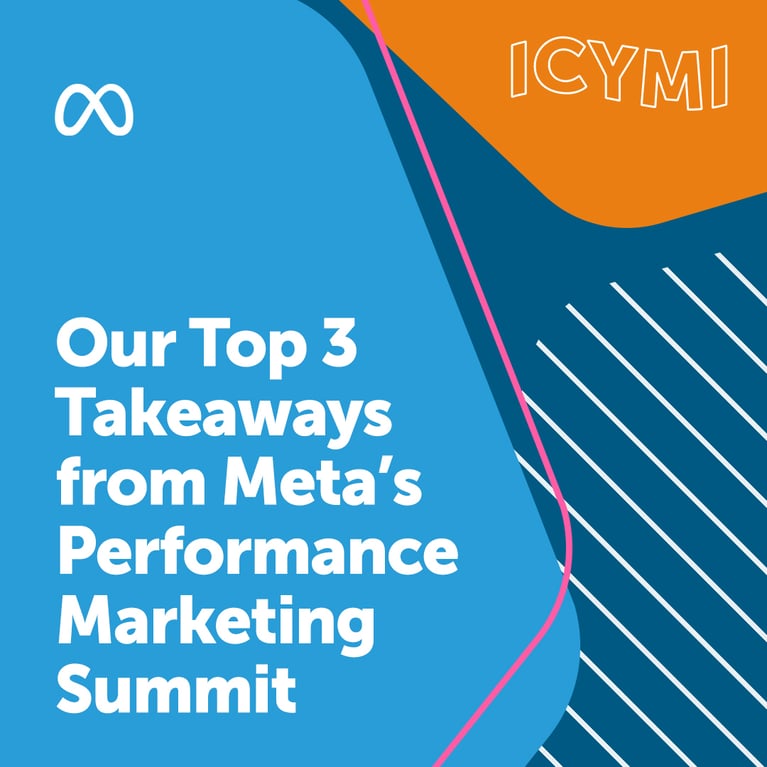On September 13, Meta invited some of its best, brightest and in my case, most skeptical performance marketers to its campus to discuss the present and future state of performance marketing on all of Meta’s properties.
The past couple of years have been a rollercoaster in the DTC world, with consumers and brands flocking to online sales during the lockdown and then flocking back to brick-and-mortar retail locations afterward in search of some sort of human interaction. While this giant game of Red Rover was happening on the consumer side, iOS 14.5 was released—sending a big bang-sized meteor straight into the ad accounts and forecasts of every dinosaur marketer out there.
This being Meta’s inaugural Performance Marketing Summit and first in-person event since Covid, I was very curious about what the head honchos at Meta had to say about the current landscape and what their plans/best practices were to ensure that we keep spending on their platforms. So, without further ado, here are four major takeaways that brands can begin implementing today:
1. Account simplification
Time and time again, we’ve heard from Meta reps tell us to simplify your ad accounts by consolidating similar audiences and/or targeting broad audiences with dynamic creative to give the algorithm as much flexibility and control as possible. While this may seem like an easy win for everyone (less campaigns + less control = less work for the hands on keyboard team), the majority of performance marketers out there have grown up watching movies like Terminator and The Matrix – and thus have a healthy distrust of the algorithm overlords having complete control over everything.
Meta has finally heard the concerns we’ve had over the years, and has begun rolling out reporting capabilities like Advantage+ Custom Audiences and a new UI that help decouple the bidding/targeting/messaging efficiencies a simplified account offers—including the who, what, when/where and most importantly WHY that marketers are looking to deduce from looking at campaign performance.
2. Creative is king (or queen)
Meta announced a staggering stat that 56% of all auction outcome is related to creative. This means that creative is the single most important lever that marketers can pull to help improve account performance; even more important than targeting, bids, etc.
With great power comes great responsibility: in order to truly be successful on the platform, brands need to have a clear creative testing roadmap that focuses on both volume (CVR drops 60% after four exposures) as well as variety. While the notion of constantly creating and iterating new creative concepts might sound daunting to most, it’s important to emphasize that multi-million dollar productions are no longer the only path to success – and partnering with an agency that already has the testing framework in place is half the battle. Here’s what we know works:
- Short form videos: 50% of time spent on all Meta platforms is watching videos with IG Reels, making up 20% of time spent on Instagram. IG Reels has been a major priority for Meta as a whole and we’ve seen major increases in reach in both paid and organic as they push this agenda.
- Embracing lo-fi: Less polished videos and photos help foster a feeling of authenticity and allows the audience to feel that authentic connection to a brand. We’ve seen low budget productions shot on iPhones outperform polished creatives countless times across multiple clients.
- Leveraging creators: 53% of people trust what a creator says about a product more than what brands say themselves.
- Elevating community voices: Tap into existing customers to source user-generated content from the people that love your brand the most.
3. Data data data
We’re all still emotionally recovering and adjusting to the post iOS14.5 world – and no one feels the pain more than performance marketers tasked with making sense of different attribution windows, modeled data and chronic platform under/over reporting. Even Meta understands that its tracking is far from perfect, which is why it enlisted the folks over at Deloitte to host a panel discussion on the importance of having a transparent and holistic measurement system that is the singular source of truth for all your data.
Luckily, Cart.com has developed Unified Analytics, which helps brands connect all of their disparate data sources (Facebook, Instagram, Google, Twitter, Snapchat, Pinterest, affiliate, Amazon and more) to not only view their most important decision making KPIs in one dashboard, but to also layer on machine learning attribution AI to help illustrate the incremental impact of each marketing channel and where to shift the spend for optimal performance.
- Over 60% of Deloitte clients are currently going through RFP for new measurement solutions
- High measurement clients use 27% more KPIs to help answer questions and dictate future strategy
- With CPG native brands going DTC and DTC native brands going to retail, brands are looking for ways to bridge first, second and third-party data to measure the impact of their marketing across all avenues
- Best practices include tracking performance through the pixel, CAPI, AND a mixed media model
4. Landing page experience
The year is 1998. You hear your mailman pull up and you run out to check your mailbox to find yet another AOL Free Trial CD – giving you access to 1,000 hours of internet browsing for free! After waiting approximately seven minutes for Windows XP to load, you pop in the AOL CD and listen to the sweet sounds of your 56k dial up modem connecting you to the World Wide Web, hoping that nobody picks up the house phone and disconnects you during your browsing session. These were the days where a brand could get by with having a less-than-stellar landing page experience … because the user just didn’t know any better.
Fast forward to today. Users are accustomed to responsive websites, customized landing pages, a cohesive customer journey and fast site speed: all table stakes just to be competitive. The folks at Meta believe that the customer experience is so important, they expanded their Performance 5 pillars to six. Our Conversion Rate Optimization services and end-to-end solutioning from design to development help build the foundation for our clients’ success and allow for consistent testing and iterations, yielding incremental gains that add up over time.
Conclusion
Overall, the event was a great time and it was amazing to be surrounded by other individuals who get excited about acronyms like MMM, API, KPI,DTC, etc. While the overarching information that was discussed wasn’t net-new to us at Cart.com, it was nice to see other thought leaders in the industry and the presented case studies reaffirm our beliefs about how to navigate this everchanging space.





